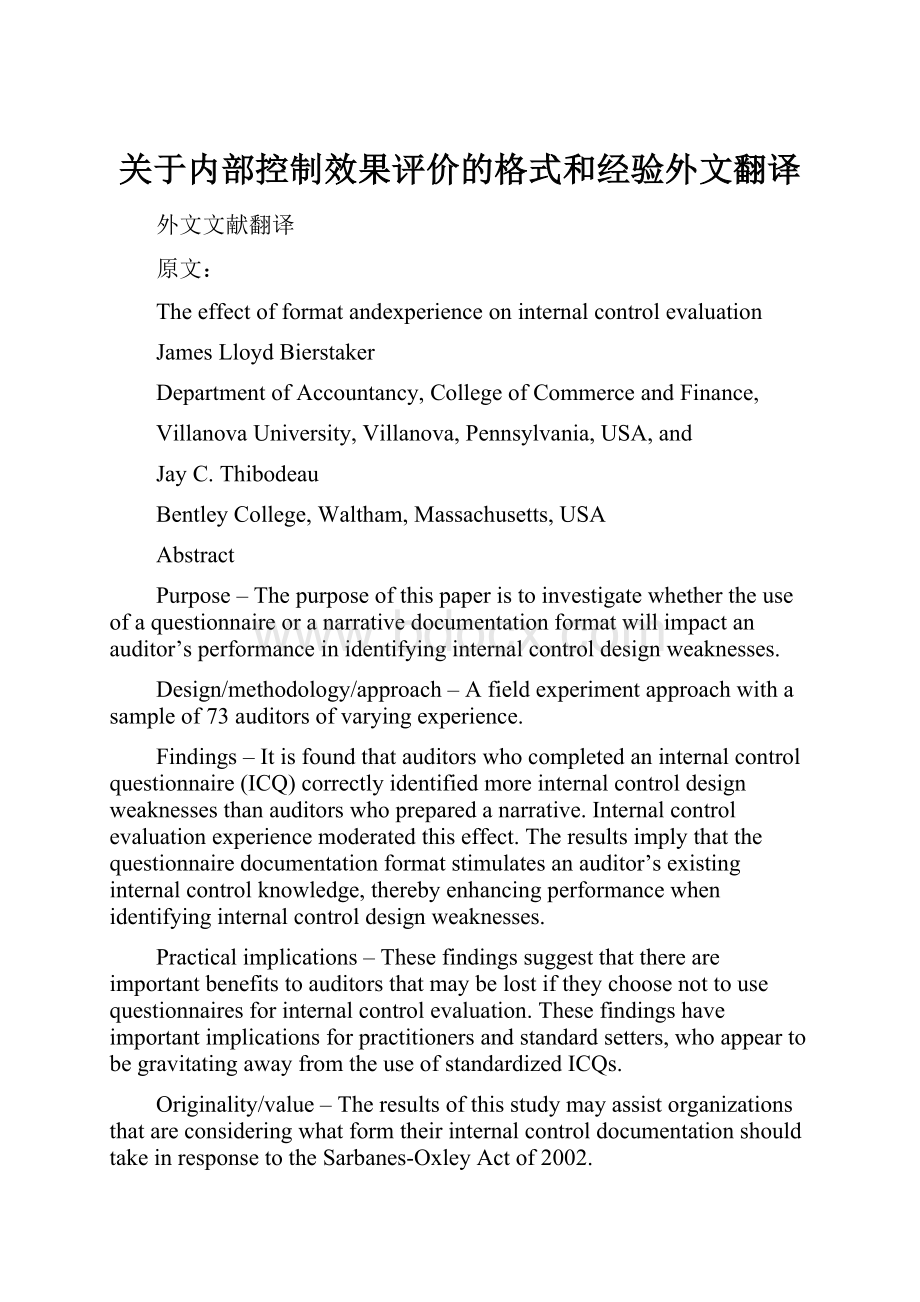关于内部控制效果评价的格式和经验外文翻译.docx
《关于内部控制效果评价的格式和经验外文翻译.docx》由会员分享,可在线阅读,更多相关《关于内部控制效果评价的格式和经验外文翻译.docx(12页珍藏版)》请在冰豆网上搜索。

关于内部控制效果评价的格式和经验外文翻译
外文文献翻译
原文:
Theeffectofformatandexperienceoninternalcontrolevaluation
JamesLloydBierstaker
DepartmentofAccountancy,CollegeofCommerceandFinance,
VillanovaUniversity,Villanova,Pennsylvania,USA,and
JayC.Thibodeau
BentleyCollege,Waltham,Massachusetts,USA
Abstract
Purpose–Thepurposeofthispaperistoinvestigatewhethertheuseofaquestionnaireoranarrativedocumentationformatwillimpactanauditor’sperformanceinidentifyinginternalcontroldesignweaknesses.
Design/methodology/approach–Afieldexperimentapproachwithasampleof73auditorsofvaryingexperience.
Findings–Itisfoundthatauditorswhocompletedaninternalcontrolquestionnaire(ICQ)correctlyidentifiedmoreinternalcontroldesignweaknessesthanauditorswhopreparedanarrative.Internalcontrolevaluationexperiencemoderatedthiseffect.Theresultsimplythatthequestionnairedocumentationformatstimulatesanauditor’sexistinginternalcontrolknowledge,therebyenhancingperformancewhenidentifyinginternalcontroldesignweaknesses.
Practicalimplications–Thesefindingssuggestthatthereareimportantbenefitstoauditorsthatmaybelostiftheychoosenottousequestionnairesforinternalcontrolevaluation.Thesefindingshaveimportantimplicationsforpractitionersandstandardsetters,whoappeartobegravitatingawayfromtheuseofstandardizedICQs.
Originality/value–TheresultsofthisstudymayassistorganizationsthatareconsideringwhatformtheirinternalcontroldocumentationshouldtakeinresponsetotheSarbanes-OxleyActof2002.
KeywordsInternalcontrol,Auditors,Questionnaires
PapertypeResearchpaper
Introduction
Auditingstandardsrequirethatoneveryengagementauditorsobtainanddocumenta
“sufficientunderstandingofinternalcontrol”toproperlyplantheauditanddetermine
thenature,timingandextentofaudittesting(USSASNo.78AICPA,1995;ISA400
IFA,2003).Inaddition,theSarbanes-OxleyAct(2002)hassignificantlyincreasedthe
responsibilitiestoevaluateinternalcontroleffectivenessforauditorsofcompaniesthatregistertotradesecuritiesintheUSA,includingallforeignregistrants.Specifically,auditorsofallpubliclytradedcompaniesmustexpressanopinionontheeffectivenessofthecompany’sinternalcontrolsystemoverfinancialreporting.Tosupportthisopinion,auditorsarerequiredtoidentifyanddescribeallmaterialweaknessesinthedesignoroperationofinternalcontrolsthatexistedatthe“asof”datefortheirclient(PCAOB,2004,A-76).
Whileauditorshavealwaysbeenrequiredtounderstandthedesignofaclient’s
internalcontrolsystemaspartofthefinancialstatementaudit,theimportanceofidentifyinginternalcontroldesignweaknesseshasnowbeendramaticallyelevated
sincepoorperformanceonthetaskcanleaddirectlytotheexpressionofincorrect
opinionsandultimatelylitigationagainsttheauditfirm.Further,foreignregistrants
arerequiredtofullycomplywiththerequirementsoftheSarbanes-OxleyAct(2002)byJuly15,2006orloseaccesstoUScapitalmarkets.Auditingstandardsbodies
throughouttheworld,includingtheISA,arecurrentlyconsideringwhetherandwhat
changestopracticearewarranted.Therefore,theSarbanes-OxleyActhashad
widespreadinfluencethroughouttheworld.
Adirectresultofthesenewauditrequirementshasbeenanincreasedfocusbyauditfirmstoimprovetheeffectivenessandefficiencyoftheprocessesusedtogainanunderstandingof,document,andevaluateacompany’sinternalcontrolsystem.Since,theimprovementofauditeffectivenessandefficiencyhasalwaysbeenoneofthefundamentalgoalsofauditjudgmentresearch(Messier,1995),thepurposeofthis
studyistoinvestigatewhethertheuseofaquestionnaireoranarrativedocumentation
formatwillimpacttheperformanceofauditorsinidentifyingweaknessesinthedesignofaclient’sinternalcontrolsystem.
Atpresent,thereisnostandardformatrequirementforauditorstofollowwhen
documentingtheirunderstandingofaclient’sinternalcontrolprocedures.Rather,
auditorsareallowedtochooseamonganumberofallowabledocumentationformats
(e.g.narrativeandquestionnaire)underbothGenerallyAcceptedAuditingStandards
(AICPA,1995)andInternationalAuditingStandards(IFA,2003).However,recent
guidancebythePCAOBindicatesauditorsshouldnotrelyonstandardized
“checklists”whenevaluatingcontrols(PCAOB,2005).Moreover,recentremarksmadebyWilliamMcDonough,ChairmanofthePCAOB,alsoindicateauditorsshouldavoida“checktheboxmentality”aboutcontroltesting(FEI,2005).Thus,researchinvestigatingtherelativemeritsofvariouschoicesthatareallowableundertheexistingauditguidanceiswarranted.
Theresultsofabetween-subjectsexperimentadministeredto73auditorsof
varyingexperienceindicatethatdocumentationformatdoesimpactanauditor’s
evaluationofaclient’sinternalcontrolsystem.Specifically,auditorswho
completedaquestionnaire(ascomparedtoanarrative)identifiedmoredesign
weaknessesinaclient’sinternalcontrolsystem.Asexpected,thetreatmenteffect
wasmoderatedbyinternalcontrolexperience.Takentogether,ourresultsimply
thatthequestionnaireformatstimulatesanexperiencedauditor’sexistinginternal
controlknowledge,therebyenhancingperformancewhenidentifyingdesign
weaknessesinaclient’sinternalcontrolsystem.
Theresultsofthisstudyareimportanttobothaudittheoryandpractice.Forsometime,practisingauditorshaveusedboththenarrativeandthequestionnaireformattodocumenttheirunderstandingofaclient’sinternalcontrolsystem(Bierstaker,1999).However,recentresearchsuggeststhatauditorsareincreasinglyrelyingonthenarrativeformat,whilequestionnaires(andotherformats)arebeingusedlessfrequently(BierstakerandWright,2004).Inaddition,recentguidancebythePCAOBmayfurtherreduceauditors’relianceonquestionnaires.Nevertheless,theresultsofthisstudysuggestthatstandardizedquestionnairesmaybevaluabletoolstoassistauditorsinevaluatingcontrolweaknesses,andthiseffectseemstoincreaseasauditorsgainexperience.Therefore,practitionersandstandardsettersmaywishtore-visitthepotentialbenefitsofusingquestionnairestodocumentandevaluatecontrols.
Theremainderofthispaperconsistsoffoursections.Hypothesesdevelopmentsectiondevelopsthehypotheses.Methodssectionpresentstheresearchdesign.Thenextsectionpresentstheexperimentalresults.Thefinalsectiondescribestheresultsandimplicationstoaudittheoryandpractice.
Hypothesesdevelopment
Thedesignofaclient’sinternalcontrolsystem
PriortoSarbanes-Oxley,auditorshadachoiceregardingthelevelofworktobecompletedonapubliclytradedclient’sinternalcontrolsystem.Thatis,auditorswereonlyrequiredtoobtaina“sufficientunderstandingofinternalcontrol”toplantheauditanddeterminethenature,timingandextentofsubstantiveaudittesting(AICPA,1995).Auditorswouldusethisunderstandingtoevaluatethecapabilityofanauditee’sinternalcontrolsystemtodetectorpreventtheoccurrenceoferrorsand/ormisstatementsinanauditee’sfinancialstatements.Themoreauditorsunderstoodaclient’sinternalcontrolprocessesandrelatedrisks,thebetterauditorswouldbeabletotakeadvantageofaneffectiveinternalcontrolsysteminplanningthesubstantiveteststhatareneededtocompletetheaudit(Winogradetal.,2000).
Now,however,theimportanceofevaluatingthedesignofaninternalcontrolsystemhasbeentakentoanewlevelofconsequences.Itisnolongerjustasteptodeterminethe“nature,timingandextent”ofsubstantiveevidencetobegathered.Rather,therearenowdirectpotentialconsequences,sinceauditorsusetheresultsoftheevaluationtoreachconclusionsabouttwoseparateauditopinions.TheheightenedimportanceofthisevaluationrepresentsoneofthemoredramaticchangesinthenewintegratedauditprocessrequiredtobecompletedonpubliclytradedcompaniesintheUSAasaresultoftheSarbanes-OxleyAct(2002).
InitsInternalControlStandard,thePCAOBhasmandatedthatmanagersofpubliclyheldcompaniesuse“arecognizedinternalcontrolframeworkestablishedbyabodyofexpertsthatfolloweddue-processprocedures”tobaseitsassessmentoftheeffectivenessofthecompany’sinternalcontroloverfinancialreporting(PCAOB,2004,A-11).Forthisassessment,theInternalControlStandardmakesspecificreferencetotheCOSOinternalcontrolframework(COSO,1992)asa“suitableandavailableframeworkforpurposesofmanagement’sassessment”(PCAOB,2004,A-11).
ThenewInternalControlStandardrequiresauditorstoevaluatewhethertheclient’sinternalcontroldesignreflectseachoftheappropriateinternalcontrolobjectives,asoutlinedintheCOSO(1992)report.Theevaluationofinternalcontroldesignoccursconcurrentlywiththeprocessofidentifyingthekeyinternalcontrolactivitiesinaclient’sinternalcontrolsystem.Eachoftheinternalcontrolobjectivesmustbesupportedbyaninternalcontrolactivity.Thestandardrecognizesthepossibilitythatasingleinternalcontrolactivitymightbedirectlysupportiveofseveralinternalcontrolobjectives.However,ifanyoftheinternalcontrolobjectivesarenotsupportedbyaninternalcontrolactivity,aninternalcontrolweakness(ordeficiency)mustbenoted.Inaddition,eachinternalcontrolweaknessidentifiedmustbeevaluatedastowhetheritcouldhaveledtoamaterialmisstatement.Iftheauditorconcludesthatthereismore
thanaremotelikelihoodthattheweaknesscouldhaveledtoamaterialmisstatement,the